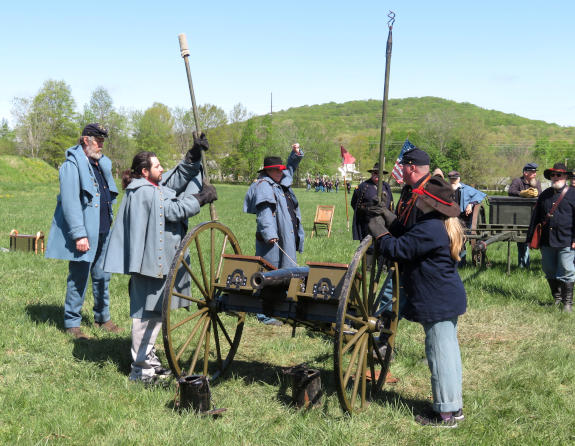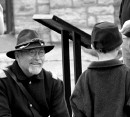NEWS OF 150 YEARS AGO
July/August 1861
From The Missouri Democrat, Wednesday, July 10, 1861.
Last Night’s Dispatches.
HIGHLY IMPORTANT FROM THE SOUTHWEST.
A Big Battle Between Seigel’s Command and the Rebels.
COL. SEIGEL, WITH 1,500 GIVES BATTLE TO 11,000 REBELS.
He Drives them Back at the First Onset.
THE FEDERAL FORCES, OVERPOWERED, FALL BACK.
In a Masterly Retreat, he makes Fearful Havoc among the Rebels.
THE VICTORY REALLY WITH COL. SEIGEL.
Later and Doubtful Accounts.
Seigel’s Command Reported Badly Cut Up.
COL. SEIGEL’S LOSS REPORTED AT FROM 300 TO 1,000.
The Rebel Loss Reported at from 1,000 to 2,000.
Gen. Lyon, Col. Brown, and Col. Sturgis Coming Up.
Gen. McCulloch Sends Troops to Aid Governor Jackson.
ANOTHER BATTLE INEVITABLE.
KANSAS CITY, July 9.—We are indebted to the editor of the Kansas Journal for a copy of the Fort Scott (Kansas) Democrat of the 7th, which contains the following account of a battle between the Missouri State troops under Gov. Jackson and Gen. Rains, numbering by their accounts, from 10,000 to 13,000, and the United States forces under Col. Sigel numbering 1,500 in all.
Our informant says, on Wednesday, the 3d inst., the State troops left Rupes point, and moved south to Murray’s, six miles.
Friday morning, at 8 o’clock, they broke up camp and marched south, in the direction of Carthage, the county seat of Jasper county. At Dry Fork, seven miles north of Carthage they were met by Col. Seigel with 1,500 men who immediately gave them battle. The first onset credited in the State troops being driven back some distance, and the officers ordered a retreat. The center gave way, but the order not being heard on the flanks the advancing United States troops were in danger of being surrounded and themselves fell back. They retreated slowly keeping up the fight, the artillery making fearful havoc among the enemy’s ranks. At the crossing of Dry Fork their lines were very near being broken, when, by the timely arrival of 200 Union men from Shoal Creek, they crossed with but a loss of five killed and two mortally wounded.
The battle continued, the United States troops alternately fighting and retreating until dark when they reached Carthage, having crossed Buck Branch and Spring River on their way.
The fighting was all done with the artillery, Col. Seigel retreating as soons as the rebels got theirs in position and playing on his ranks as they advanced. It is believed that Col. Seigel’s object was to draw the State troops on to Carthage, where with 400 reserves left at that place, and expected reinforcements from Neosho and Sarcoxie, he would be enabled to turn and drive them back or route them.
The loss on Jackson’s side was very great. Our informant states that he counted between seventy and eighty wounded on the field and in the houses, by the way side at Dry Fork. A large amount of beef was thrown out of the provision wagons, it is supposed, to make room for the dead.
Another informant, a resident of Carthage, states he passed over a part of the battle field yesterday morning, and says he saw wagons and hacks passing in every direction, gathering up the dead for interment.
The loss on the part of the State troops cannot be less than from 300 to 500. The ground in many places was strewn with dead horses, and the stench was sickening. The whole country was laid desolate, fences torn down, crops trampled into the ground, and houses plundered. He met parties of women who stated that everything had been taken from them by the State troops except what they had on their backs.
The retreat of the federal forces was conducted in a style worthy of veteran troops, with as much coolness as on the parade ground instead of the field of battle. It was only the overwhelming odds on the side of the secessionists, that enabled them to carry the day. The victory was really with Seigel.
It was reported that a night attack had been made on Col. Seigel, and 400 of his men killed and 600 taken prisoners, and three pieces of artillery captured, but our informant says he overheard a messenger from the secession camp state that they had killed but one man after entering Carthage, and had taken no guns.
Jackson announced his intention of fortifying at Carthage until Price and McCulloch can arrive from Arkansas with reinforcements, when he will turn and act on the offensive, and enforce the laws of the State.
Col. Segel retreated in the direction of Sarcoxie, where he expected reinforcements. Nothing can be heard from Major Sturgis or Gen. Lyon.
LATER.
July 7th, 8 P. M.—A citizen of this place has just arrived, having left Sherman, Jasper county, Mo., at daylight this morning. He states that after leaving Carthage, Col.. Segel encamped two miles southeast of the town, where he was attacked in the night, and his command badly cut up. His loss is variously estimated at from 500 to 1,000, and that of the secessionists from 1,000 to 2,000 killed and wounded.
Col. Brown, with 3,000 troops from Springfield is said to have joined Segel.
Major Sturgis is north of Osage, and Gen. Lyon, at last accounts was at Warsaw, on his way south.
On Friday Ben McCulloch and General Price arrived at Neosho, twenty miles south of Carthage, with 5,000 men. A guard of 200, left there by Col. Segel, was surrounded and taken prisoners. One account says all were murdered, while another states that but a small number of them were killed. McCulloch sent forward 2,000 to assist Jackson. He expects 5,000 additional troops from Arkansas.



